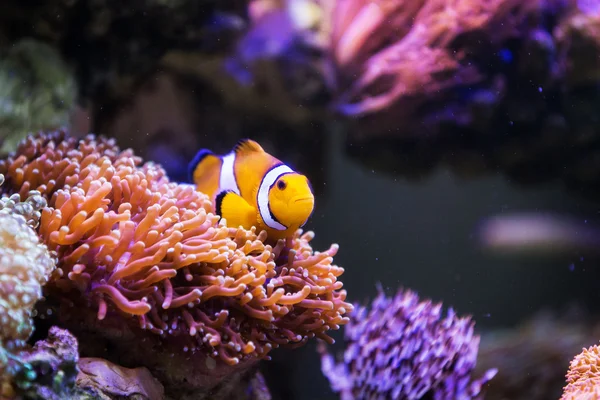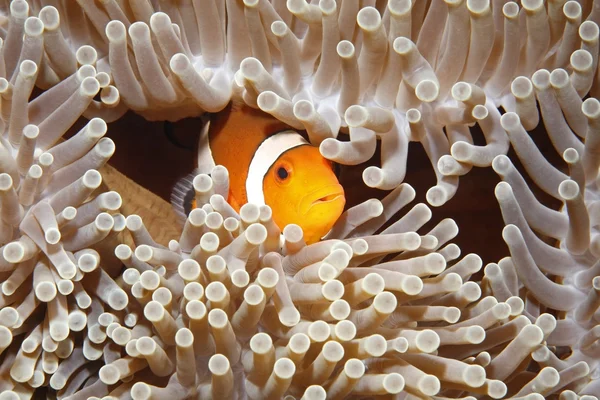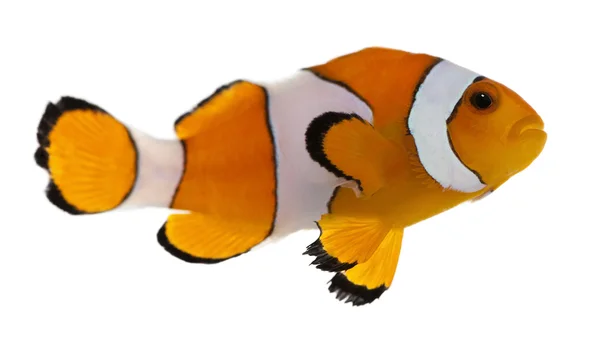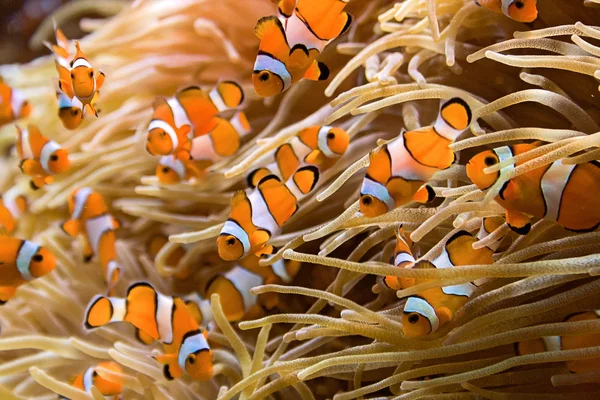New clownfish owners are sometimes surprised to see particular shocking behavior in their fish, including their sleeping pattern. Sometimes clownfish sleep lying down at night. So when the lights come on, the first thing they see is a fish that looks quite dead or distressed.
Many pet owners understandably start searching for answers at this point. After all, aren’t fish always in constant motion, even at the same hours other animals go to sleep? But, how do clownfish sleep at night? Let’s find out!
Do Fish Sleep?
Many animals sleep at night, and fish are no exception. Fish owners who turn on the aquarium light suddenly will often see their fish sleeping behavior. Usually, fish will hang out near the bottom or in a cave. Their colors become pale, and they are barely moving.

What Is REM Sleep?
Unlike mammals like humans, fish don’t have a neocortex. So they probably don’t dream. But when clownfish sleep, they do show similar behavior to us in having a stage like REM.
REM is rapid eye movement and is a stage where a sleeping person’s eyes begin to dart around when they fall into a deep sleep. REM sleep is critical to getting enough rest, so it’s no surprise that fish have a similar sleeping pattern.
Is Blue Light Good When Clownfish Sleep?
Many modern LED light fixtures have “moonlight blue” output that is advertised to be run at night when fish normally fall asleep. But these lights actually force fish to remain active and disrupts their normal sleeping pattern.
Blue light is what animals (including humans) use to regular their circadian rhythms. And too much blue light forces animals to stay awake, including most fish.
Nocturnal fish also have their habits disrupted if they can’t move in the dark naturally. If they are forced to stay awake consistently, it is as stressful for your pets as it is for us humans. So always turn off your fish tank lights at night – this way, your fish remain asleep peacefully.
Do Clownfish Lay Down To Sleep?

At first, you might think you have a dead fish when turning on the lights in the morning. But not only do clownfish sleep at night – they are known to sometimes lie down.
Clownfish sleep on their sides if they don’t have a hole to wedge themselves into. Or they may simply prefer a soft, sandy bottom of the tank to empty coral or live rock crevices.
It is perfectly normal to see a clownfish sleep on its side. As long as it perks back up in the morning, then you need not worry about how your fish sleep!
Clownfish Swimming Slowly
But what if your clownfish’s sleeping behavior isn’t normal? What if it does not swim normally after the lights come back on?
First of all, you should remember that clownfish are fairly unusual swimmers! They use their very soft pectoral fins to sort of “pull” themselves through the water.

Compared to other fish, this motion looks very clumsy. In fact, their wobbly way of swimming is part of the reason why they are called clownfish (the other is their explosively bright colors).
But this habit of slow swimming is not a bad thing. Since clownfish live in sea anemones, they don’t need to be fast swimmers. And by using their pectoral fins, they can carefully maneuver around tentacles and other obstacles with ease.
Do Clownfish Need A Sea Anemone To Sleep?
Clownfish are often called “anemonefish” because, in their natural habitat, they are usually found alongside them. They share a symbiotic relationship with sea anemones, a relationship where both animals benefit from the exchange.
The clownfish eat, spawn, and sleep in their host anemone. Being small fish that are poor swimmers, they also gain protection thanks to the potent stings of their host. And the host anemone gets food and protection from the clownfish, which will chase away butterflyfish and other anemone-nibblers.
Since most clownfish sleep close to home, they will gladly snuggle into the tentacles of their sea anemone home. As you can see in the below video, clownfish sleeping behavior can include a sea anemone!
But just because sleeping clownfish enjoy an anemone pillow does not mean you have to own one.
Are Sea Anemones Easy To Keep?
One reason not to buy a sea anemone is that they are dangerous tank mates for most animals. Their tentacles are covered in nematocysts, stinging cells that lash out when touched.
These inject poison into other fish that touch them. Clownfish sleep in anemones because they have protective mucus that does not trigger the stings.
But a sleeping fish that is startled awake and bolts might end up dashing into a sea anemone, which can kill it if the species has a stronger sting. Some are known to be fish eaters, especially carpet anemones.
Another reason not to keep sea anemones is that they are not easy to care for. Clownfish owners that want a sea anemone have to provide excellent water quality for them. They are highly sensitive to dissolved nitrogenous waste products (ammonia, nitrite, nitrate).
Related: How to Take Keep Bubble Tip Anemone (Care Guide)
Most need just the right amount of current to prosper. Anemones also need powerful, full-spectrum aquarium lights as they are photosynthetic animals.
But if you are willing to provide all of this, then you will have a show like no other. You can even keep multiple clownfish that prefer sleeping inside anemones! Many will share their home with other fish or baby clownfish of the same species.
Which Sea Anemone Should I Get?
Clownfish sleep anywhere, but they do love a cozy sea anemone for a pillow. One complication to keeping them is that clownfish are sometimes picky about which anemone they will accept.
In their natural habitat, most clownfish sleep only in specific sea anemones. A few, such as the Clarkii Clownfish (Amphiprion clarkii), will sleep laying in any of the 10 favored host anemones.
But others, like the Maroon Clownfish (Premnas biaculeatus), associate exclusively with Bubble-tip Sea Anemones (Entacmaea quadricolor).
The 10 species of sea anemone to choose from for your clownfish’s sleep habit include:
- Bubble-Tip Sea Anemone
- Sebae Anemone
- Saddle Anemone
- Bearded Anemone
- Giant Carpet Anemone
- Magnificent Sea Anemone
- Delicate Anemone
- Merten’s Carpet Anemone
- Adhesive Anemone
- Long Tentacle Anemone
Why Is My Clownfish Staying At The Bottom Of The Tank?

A clownfish sleeping on its side is a natural behavior. But sometimes, it can also be a sign that something is wrong.
Signs My Clownfish Is Sick
We know that clownfish sleep on their sides sometimes. But if your fish isn’t getting back up in the morning, then you should be concerned. What are some signs that your clownfish lying on its side is a sign that it is sick?
- Dull coloration even after the lights have been on for hours
- Excess mucus production
- Cloudy eyes
- Visible injuries
- Frayed or torn fins
- Disrupted breathing (too rapid or too slow)
- Not moving even if the fish owner prods it
The exact nature of the illness or injury is beyond the scope of this article. Perhaps the clownfish is being bullied by a tank mate. Or maybe one of your water parameters is out of the normal range.
Just remember that anytime a fish decides to stop swimming, it is a sign that you need to look into the aquarium conditions.
How Do I Know If My Clownfish Is Happy?
As long as your clownfish sleep and then perk back up first thing in the morning, you don’t need to worry if it likes to sleep at the bottom. But what else can we do to keep our clownfish happy under our care as pet owners?
Tips For Making Clownfish Happy

Add food to their diet that provides diversity. Fresh and frozen food are delights that spice up a life of bland prepared flakes and pellets. Brine shrimp, tubifex worms, copepods, and other treats also provide essential elements that might be missing in their usual fare.
If you want to enjoy the spectacle of the symbiotic relationship clownfish have with sea anemones, then research how to care for these amazing animals. Sea anemones are intermediate level in difficulty, but they are well worth the effort. Watching your clownfish sleep and dance through their tentacles is one of the most incredible spectacles of the marine aquarium hobby!
Choosing tank mates that are well suited to the gentle nature of most clownfish is also a good idea. A few of the larger species, such as Maroon Clownfish, are quite aggressive. But most clownfish are very gentle and only want community aquarium fish included that are just as peaceful and easygoing as they are.
Last, you can try keeping more than two clownfish in the same tank. Many species are social so long as they are introduced together when very young. As long as the aquarium and their host anemone are large enough, they will gladly share space and form a community.
One of the clownfish will become the dominant female, which will grow larger and more aggressive than the others.
And with luck, you may even get to watch your clownfish spawn! They are excellent parents, and the eggs hatch within 2 weeks of being laid. Captive-bred clownfish are always in high demand at local pet stores, making this a very easy money-making side project for you!
Wrapping Up
So, do clownfish sleep? Yes, they do!
In fact, clownfish sleep on their sides sometimes. They aren’t the only fish to do this – but it can be alarming if you aren’t aware of this sleeping habit. But as long as your clownfish swim normally when the lights come on, you don’t have much to worry about!
Related Interesting Reading:
- The Different Kinds of Clownfish
- How Many Eggs Do Clownfish Lay and Do They Eat Them?
- How Long Should I Keep My Fish Tank Lights On?
- Do Barracudas Actually Eat Clownfish?
- How Long Do Clownfish Live?

